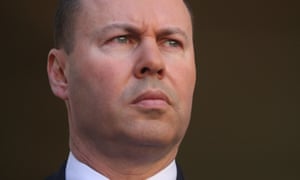Special investigation: In the first of a new series
examining the impact of the federal government’s recovery spending,
economists urge the Coalition to outline what it is planning after
September
With
news last Friday that the centrepiece of Australia’s coronavirus
stimulus package, jobkeeper, will cost $60bn less than forecast, the
federal government has an opportunity to rethink its approach to address
what economists are referring to as “the cliff”.
The cliff, or “gap”, refers to the fact that almost all of the stimulus measures put in place by the government to soften the blow of the Covid-19-induced economic shutdown will run out by September. And then what?
In a new series, Stimulus under scrutiny, Guardian Australia has
undertaken an investigation into how the coronavirus support programs
are working, what role they play in cushioning the blow of the
shutdowns, and where they are not working.The cliff, or “gap”, refers to the fact that almost all of the stimulus measures put in place by the government to soften the blow of the Covid-19-induced economic shutdown will run out by September. And then what?
We have asked economists and experts how they need to be tweaked to ensure that they address inequities and better assist in Australia’s economic and social recovery.
The federal budget is not due until October and, at this point, there’s no clear roadmap about what will happen beyond that point.
The treasurer, Josh Frydenberg, has promised “an updated economic and fiscal outlook” in June but it is unclear whether this will be more than a mid-year economic statement, which summarises the financial position, or an unveiling of what will happen after September.
Increasingly economists are urging the government to show its hand on economic support beyond September or bring the budget forward.
Greg Smith, a former deputy secretary of Treasury, was early in calling for an economic update in May, something Frydenberg took up. But Smith says more needs to be done.
“There is a mismatch in the timing in front of us,” he said in a webinar organised by the Committee for Economic Development of Australia. “The budget is set down for October but the economic crisis response is set down to expire in September. This is to say that everything that we have set down expires before the budget.
“We have a gap, which is why I called for an economic statement to start the process of being prepared for that gap. If we respond to the gap we are effectively having a budget before the budget. It is really important to realise that we have to get on to this job because we are getting some timing mismatches.”
There are no easy answers but clearly “the cliff” that looms in September needs to be addressed .
Both sides of politics have acknowledged that jobkeeper and jobseeker are fundamental to keeping Australians fed, housed and connected to workplaces.
Jobkeeper is due to end on 27 September. Jobseeker recipients will revert to Newstart, also at the end of September, which will mean a cut of 50% in the value of the payments and reversion to more stringent asset and income tests for partners, plus a requirement to be actively seeking work.
“When jobseeker payments fall, it will affect growth further,” Pradeep Philip, head of Deloitte Access Economics, told Guardian Australia.
“In previous crises we have tried to give money to people who need it and who will spend it. This is the conundrum the government needs to sort out. It needs to find a transition pathway.”
Access Economics refers to this task as “job tweaker”.
On the other hand, these labour support schemes also come with an eye-watering cost to the Australian public. Jobkeeper is expected to cost $70bn up to September, while the jobseeker supplement – the temporary increase – costs $14bn extra.

These include cash flow subsidies paid via the tax office by way of a waiver on their pay-as-you go-tax-payments, at a cost of $32bn. Another is the government’s loan guarantee scheme for small and medium business, whereby the government guarantees 50% of business loans and banks agree to let businesses put off regular payments.
These measures are also due to run out in September.
But while some businesses are showing signs of recovering as restrictions are lifted – hotels and restaurants are gradually welcoming back patrons – Deloitte’s work shows other sectors, such as finance and housing, will feel the effects of the downturn much later.
Other measures, designed to preserve crucial infrastructure that allows parents to take part in the workforce, will run out even earlier in June.
For example, childcare operators receive from the government 50% of the total revenue they were receiving before the pandemic, a measure designed to work in tandem with the jobkeeper wage subsidy payments. In return, childcare centres did not charge parents fees and remained open.
The package was put in place for three months from April, with an option to extend it for another three. The Coalition has indicated the support is not likely to continue in its current form.
That has left many within the sector worried about what comes next. Parents are facing the prospect of somehow meeting childcare fees with no work or insecure work.
Virtually all economists agree that the next phase – the transition to recovery – is just as important as the first phase, and that it is not realistic to end support measures in September.
“We have basically spent about $200bn transferring net wealth from the public sector to the business community and the household sector,” Smith said. “I suspect that won’t be the end of it by any means.”
At the start of the pandemic, the government talked of an “economic snapback” that it hoped would occur as businesses restarted and people returned to their jobs.
But last Thursday the head of Treasury, Steven Kennedy, told the Senate Covid-19 committee it was likely to take some time for the economy and the jobs market to get back to normal.
“I’m not predicting a V-shape recovery,” he said. “But, given the nature of the shock, if the government responds well with its fiscal levers, we needn’t have an L-shaped recovery, which is what people would think when it comes to a depression.”
Philip says the government and the public need to start thinking about a long and uneven recovery, in which some sectors bounce back while others slow later and take longer to recover.
“People say we are going from dealing with the pandemic to dealing with the economy, but they are not linear,” he said.
“Concepts like hibernation lend themselves to this idea, that we can deal with one problem, then the another. But we are going to have to live with Covid-19 for a while and, at the same time, we need to figure out how to open up and stage a recovery.
“We went uniformly into lockdown but we will emerge in stages.”
The design of any economic assistance during this recovery phase is important.
“You don’t want to have only kicked the can down the road,” Philip said. “You want to have built up the base of the economy.”
For instance, it might be better to invest in skills and retraining than simply providing income support for people without work. Measures that delay collapse or the repayment of debts can be helpful during a crisis but can load up businesses with more liabilities as they are trying to rebuild.
Smith warns that uncertainty itself potentially has a high economic cost.
“We really need the government to do everything it can to reduce uncertainty,” he said. “What we have to understand is that we can’t predict entirely what is going on. We face what various writers have been referring to as ‘radical uncertainty’.”
“The challenge in this situation is not to predict what will happen or when, but to anticipate the possibilities, work out what you know, and establish a set of rules that let people know how you are going to behave as these things unfold.”
• Tomorrow: the dilemma of jobkeeper and jobseeker

No comments:
Post a Comment